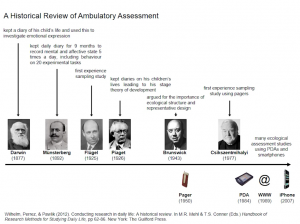In this talk, Jutta Mata highlights major advantages of experience sampling methods in the health behavior field.
Interestingly, she begins by implying that the experience sampling is mobile-based, and uses this handy timeline of experience sampling history:
And, you can check out our blog about the history of experience sampling.
After the quick jaunt, Mata discusses the major advantages, which are that ESM/EMA:
- Helps people avoid retrospection
Remembering accurate details about the past can be difficult. If you’re asked questions about what happened recently, answering more accurately is easier.
- Helps increase ecological validity
People can answer questions in their natural environment. One problem with using a laboratory for research is that everyday situations might not be accurately replicated. Further, interventions and everyday behaviors cannot be observed – in daily life.
For example:
A study wanting to observe the relationship between physical activity and affect in depressed individuals found that even small amounts of physical activity during the day improved their positive affect. This relationship was not able to be seen when participants had to come into the lab.
- Can be used to observe intra-individual variability
a. Time: How do people change over time? Experience sampling can show how different traits, such as affect change in a person over time.
For example:
A study wanted to see what effect physical activity had on affect over time: they observed that affect increased during activity and remained elevated a few hours after the activity.
b. Between and within person: How do certain variables influence behavior in comparison with the same person, and other people?
For example:
How does physical activity, sleep, positive, and negative affect influence learning goals and performance on an important exam? When comparing different people, they could see that physical activity lead to higher positive affect, which mediated the relationship between physical activity and improved learning goal outcomes. However, on the intra-individual level- which involved data that was gathered at multiple points of time- they could see that on days that individuals exercised more, they had higher positive affect, and increased improvement on their learning goal outcomes.
c. Comparing with the same person: How do individuals change?
For example:
Continuing with the above study, researchers observed how changes in sleep, physical activity, and snacking affected positive affect, and, thus, learning goal outcomes in individuals. Mata says this is important because in the past, you had to make people comparable in order to observe differences between them, so you’re not comparing “apples to pears.” However, with experience sampling, there is not a need to make people comparable because you can compare people with themselves.
- Can be used as intervention methods
There have been thousands of experience sampling-type healthcare apps that have been developed in the last couple of years- and they offer a lot of promise. However, there are a few considerations for these apps. Mata brings up several interesting questions regarding the gathered data, including privacy and data management. In the past, ambulatory/ecological momentary assessment has been more successful in health behavior (such as weight loss) than in psychological treatment. However, although many apps report positive results, few (if any) are currently empirically based, or tested.
Experience sampling is a promising method of studying and influencing healthcare-related behavior, and is technologically advancing. As a result, this method should prove to allow for exciting advancements in the field of behavioral healthcare.

